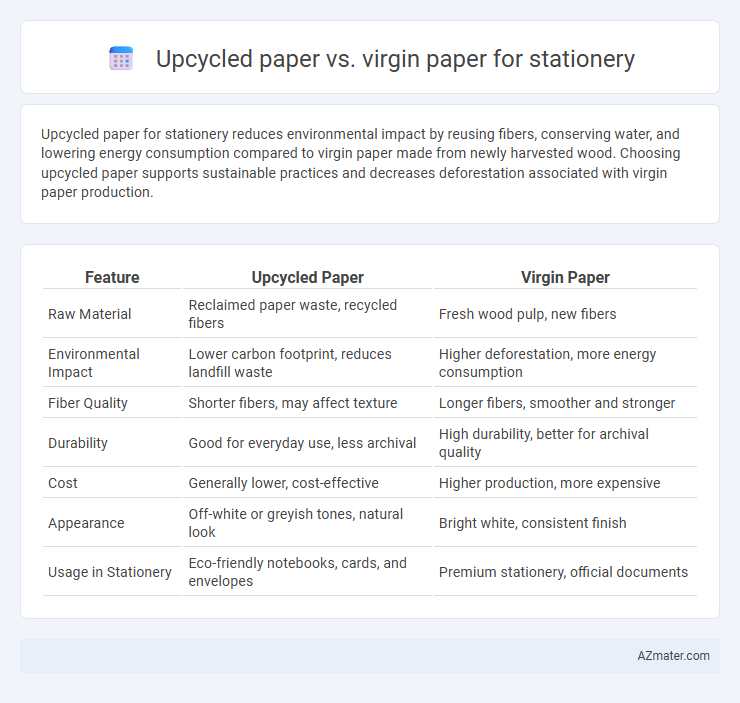Upcycled paper for stationery reduces environmental impact by reusing fibers, conserving water, and lowering energy consumption compared to virgin paper made from newly harvested wood. Choosing upcycled paper supports sustainable practices and decreases deforestation associated with virgin paper production.
Table of Comparison
| Feature | Upcycled Paper | Virgin Paper |
|---|---|---|
| Raw Material | Reclaimed paper waste, recycled fibers | Fresh wood pulp, new fibers |
| Environmental Impact | Lower carbon footprint, reduces landfill waste | Higher deforestation, more energy consumption |
| Fiber Quality | Shorter fibers, may affect texture | Longer fibers, smoother and stronger |
| Durability | Good for everyday use, less archival | High durability, better for archival quality |
| Cost | Generally lower, cost-effective | Higher production, more expensive |
| Appearance | Off-white or greyish tones, natural look | Bright white, consistent finish |
| Usage in Stationery | Eco-friendly notebooks, cards, and envelopes | Premium stationery, official documents |
Introduction to Upcycled and Virgin Paper
Upcycled paper is made by repurposing used paper products, reducing waste and conserving natural resources compared to virgin paper, which is derived directly from fresh timber. Virgin paper offers higher strength and brightness due to the use of new fibers, while upcycled paper typically features a more textured, eco-friendly appeal ideal for sustainable stationery. Choosing between upcycled and virgin paper involves balancing environmental impact with desired quality and appearance for stationery products.
Environmental Impact: Upcycled vs Virgin Paper
Upcycled paper significantly reduces environmental impact by reusing existing paper fibers, which conserves trees and decreases water and energy consumption compared to virgin paper production. Virgin paper production involves harvesting fresh wood pulp, leading to deforestation and higher greenhouse gas emissions due to intensive processing. Choosing upcycled paper for stationery supports waste reduction, lowers carbon footprint, and promotes sustainable resource management.
Raw Material Sourcing and Sustainability
Upcycled paper for stationery is created from post-consumer waste materials, reducing the demand for virgin wood pulp and minimizing deforestation. Virgin paper relies on freshly harvested trees, requiring intensive water, energy, and chemical inputs during processing, which contributes to higher environmental impact. The use of upcycled paper promotes circular economy principles by diverting waste from landfills and lowering carbon emissions associated with raw material extraction and production.
Energy and Water Consumption Comparison
Upcycled paper for stationery significantly reduces energy consumption by up to 50% compared to virgin paper, as it bypasses the extensive pulping process required for fresh fibers. Water usage in producing upcycled paper is drastically lower, with estimates showing a 40-60% reduction relative to virgin paper manufacturing, which demands large volumes for fiber processing and bleaching. Choosing upcycled paper supports energy efficiency and water conservation, aligning with sustainable stationery practices that reduce environmental impact.
Carbon Footprint Differences
Upcycled paper for stationery significantly reduces carbon footprint compared to virgin paper by lowering the demand for new raw materials and minimizing energy-intensive processing. Virgin paper production involves extensive deforestation and higher greenhouse gas emissions due to pulp extraction and chemical treatments. Choosing upcycled paper decreases overall carbon emissions by recycling existing fibers, promoting sustainable resource use in stationery manufacturing.
Quality and Performance in Stationery Applications
Upcycled paper in stationery offers eco-friendly benefits but may have lower brightness and durability compared to virgin paper, which delivers consistent high-quality texture and strength essential for professional documents and fine printing. Virgin paper's premium fibers contribute to superior ink absorption, preventing smudging and enhancing print sharpness in notebooks, cards, and envelopes. While upcycled paper supports sustainability goals, virgin paper remains the preferred choice for applications demanding exceptional performance and pristine finish.
Cost Analysis: Which is More Economical?
Upcycled paper generally offers a more economical option for stationery due to lower production costs stemming from recycled materials and reduced energy consumption compared to virgin paper, which requires raw timber and intensive processing. While virgin paper often guarantees higher quality and durability, upcycled paper provides cost savings by minimizing resource extraction and waste, making it a budget-friendly alternative for bulk or everyday stationery needs. Pricing varies with factors such as manufacturing scale, regional availability, and desired paper characteristics, but on average, upcycled paper can reduce expenses by 10-30% compared to virgin paper.
Aesthetic and Design Considerations
Upcycled paper offers unique textures and subtle color variations that enhance handcrafted stationery designs, appealing to eco-conscious consumers seeking an artisanal look. Virgin paper provides consistent smoothness and brightness, ideal for high-quality printing and sharp detail in professional stationery. Designers prioritize upcycled paper for rustic, organic aesthetics, while virgin paper suits polished, refined presentations.
Certifications and Eco-labels to Look For
Upcycled paper for stationery often carries certifications like FSC Recycled and Green Seal, indicating responsible sourcing and reduced environmental impact, while virgin paper typically features FSC or PEFC certification, ensuring sustainable forest management. Eco-labels such as EU Ecolabel and Blue Angel can be found on both types, signifying low emissions and chemical use during production. Choosing stationery with recognized certifications and eco-labels guarantees adherence to environmental standards and supports sustainable paper consumption.
Making an Informed Choice for Sustainable Stationery
Upcycled paper for stationery significantly reduces environmental impact by reusing waste materials, conserving trees, water, and energy compared to virgin paper, which requires fresh pulp from forests. Choosing upcycled paper supports circular economy principles and decreases landfill waste, making it an eco-friendly option for sustainable stationery. Evaluating factors such as print quality, texture, and environmental certifications helps consumers make an informed choice aligned with sustainability goals.

Infographic: Upcycled paper vs Virgin paper for Stationery
 azmater.com
azmater.com